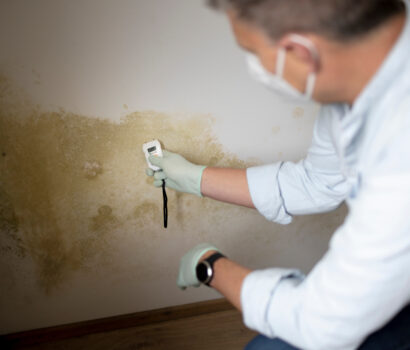Wood is commonly used in building structures, flooring, cabinets, furniture, and more. As a porous, organic material, wood is highly susceptible to water damage and mold growth. Flooding can certainly damage wood, but even high humidity is often enough to cause a mold problem.
How to Prevent Mold on Wood
Follow these tips to keep wood clean, dry, and mold-free:
- Seal wood to prevent mold: You can treat clean lumbar with mold prevention spray, which lowers its moisture uptake. This can be a purely preventative measure or follow mold treatment to reduce the chance of future fungal problems.
- Clean up standing water: Check your under-sink cabinets regularly for signs of plumbing leaks. Wipe up any pools of water you find and repair the leak as soon as possible.
- Don’t install wood flooring in the basement: Basements have notoriously high humidity and flood risk. That’s why wood flooring (along with carpet) is often not recommended for the underground level of your home.
How to Treat Moldy Wood
If the affected area is smaller than about 10 square feet, the EPA says it’s safe to remove mold yourself using household cleaners. But don’t delay—the longer you wait, the higher chance the mold colony has of spreading and affecting your health. Don the proper protective clothing and get to work removing mold from wood using any of these five cleaning methods:
- Dishwashing soap and warm water: Squirt about a teaspoon of dishwashing soap into a spray bottle, fill with warm water, and shake to combine. Spray the affected area and scrub with a soft-bristled brush. Dry thoroughly with a towel.
- Distilled white vinegar: Combine equal parts vinegar and warm water in a spray bottle. Mist the affected area and allow the solution to sit for one hour. Wipe with a damp cloth, followed by a dry towel.
- Borax: Use this safe bleach alternative on painted or stained wood. Combine one tablespoon borax with one cup water. Apply to the affected area with a soft-bristled brush. Scrub away the mold, but leave the borax solution on the wood. Aim a fan at the treated surface to help it dry more quickly.
- Detergent and diluted bleach: If mold has penetrated unfinished wood, clean it with one part detergent, 10 parts bleach, and 20 parts warm water. Apply to the affected area with a soft-bristled brush and scrub thoroughly. Allow the solution to air-dry.
- Sanding: If any mold remains after attempting the above steps, sand the wood with 100-grit sandpaper. Vacuum the affected area to remove sawdust and loosened mold spores. Repaint the wood, if needed.
Need more help removing mold from wood? Reach out to Bactronix! We are Pittsburgh’s mold removal experts, offering everything from inspection and testing to treatment and remediation. Our exclusive Bactronizing™ Process uses environmentally friendly disinfectants for highly effective results against mold and other dangerous microorganisms. To learn more or request a mold remediation quote, please call 412-375-7886 or contact us online.





